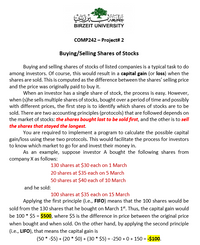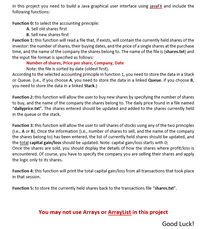
Database System Concepts
7th Edition
ISBN: 9780078022159
Author: Abraham Silberschatz Professor, Henry F. Korth, S. Sudarshan
Publisher: McGraw-Hill Education
expand_more
expand_more
format_list_bulleted
Concept explainers
Question

Transcribed Image Text:BIRZEIT UNIVERSITY
COMP242 – Project# 2
Buying/Selling Shares of Stocks
Buying and selling shares of stocks of listed companies is a typical task to do
among investors. Of course, this would result in a capital gain (or loss) when the
shares are sold. This is computed as the difference between the shares' selling price
and the price was originally paid to buy it.
When an investor has a single share of stock, the process is easy. However,
when (s)he sells multiple shares of stocks, bought over a period of time and possibly
with different prices, the first step is to identify which shares of stocks are to be
sold. There are two accounting principles (protocols) that are followed depends on
the market of stocks: the shares bought last to be sold first, and the other is to sell
the shares that stayed the longest.
You are required to implement a program to calculate the possible capital
gain/loss using these two protocols. This would facilitate the process for investors
to know which market to go for and invest their money in.
As an example, suppose investor A bought the following shares from
company X as follows:
130 shares at $30 each on 1 March
20 shares at $35 each on 5 March
50 shares at $40 each of 10 March
and he sold:
100 shares at $35 each on 15 March
Applying the first principle (i.e., FIFO) means that the 100 shares would be
sold from the 130 shares that he bought on March 1*. Thus, the capital gain would
be 100 * $5 = $500, where $5 is the difference in price between the original price
when bought and when sold. On the other hand, by applying the second principle
(i.e., LIFO), that means the capital gain is
(50 * -$5) + (20 * $0) + (30 * $5) = -250 + 0 + 150 = -$100.

Transcribed Image Text:In this project you need to build a Java graphical user interface using javaFX and include the
following functions:
Function 0: to select the accounting principle:
A. Sell old shares first
B. Sell new shares first
Function 1: this function will read a file that, if exists, will contain the currently held shares of the
investor: the number of shares, their buying dates, and the price of a single shares at the purchase
time, and the name of the company the shares belong to. The name of the file is (shares.txt) and
the input file format is specified as follows:
Number of shares, Price per share, Company, Date
Note: the file is sorted by date (oldest first).
According to the selected accounting principle in function 1, you need to store the data in a Stack
or Queue. (i.e., if you choose A, you need to store the data in a linked Queue. if you choose B,
you need to store the data in a linked Stack.)
Function 2: this function will allow the user to buy new shares by specifying the number of shares
to buy, and the name of the company the shares belong to. The daily price found in a file named
"dailyprice.txt". The shares entered should be updated and added to the shares currently held
in the queue or the stack.
Function 3: this function will allow the user to sell shares of stocks using any of the two principles
(i.e., A or B). Once the information (i.e., number of shares to sell, and the name of the company
the shares belong to) has been entered, the list of currently held shares should be updated, and
the total capital gain/loss should be updated. Note: capital gain/loss starts with 0;
Once the shares are sold, you should display the details of how the shares where profit/loss is
encountered. Of course, you have to specify the company you are selling their shares and apply
the logic only to its shares.
Function 4: this function will print the total capital gain/loss from all transactions that took place
in that session.
Function 5: to store the currently held shares back to the transactions file "shares.txt".
You may not use Arrays or ArrayList in this project
Good Luck!
Expert Solution
This question has been solved!
Explore an expertly crafted, step-by-step solution for a thorough understanding of key concepts.
Step by stepSolved in 2 steps

Knowledge Booster
Learn more about
Need a deep-dive on the concept behind this application? Look no further. Learn more about this topic, computer-science and related others by exploring similar questions and additional content below.Similar questions
- (c) Students must register for 120 credits each year. (d) Students must take at least 90 credits of CS modules each year.arrow_forward6. Cryptography, the science of encrypting and deciphering messages written in secret codes, has played a vital role in securing information since ancient times. More recently, with millions of financial transactions conducted over the Internet daily, cryptography has become more important than ever. Companies has begun to make online transactions more secure by installing encryption software to prevent sensitive information such as credit card numbers from falling into the wrong hands. Cryptology is real-world application of matrix inverses and used to encode and decode secret messages. Solve the problem below using the application of matrices in cryptography. The ciphers that will be used is called Hill ciphers. Coding system Each letter is assigned a number based on its position. ABCDEFGHI JKLM 1 2 3 4 5 6 7 8 9 10 11 12 13 NOPQ RSTUVWXY Z 14 15 16 17 18 19 20 21 22 23 24 25 0 To get the numbers in the code range (0 to 25), reduce the numbers in the matrices to their equivalents mod…arrow_forwardFind two cases in the media (internet, TV, etc.) of a person (organization, etc.) attempting to describe and example of the process of Darwinian evolution but is incorrectly describing the evolution process using a Lamarckian approach to evolution. Give the following information for both cases: Source (Where you found it) In what ways are they mistakenly claiming that the evolutionary process is an example of Darwinian evolution? How do you know that they are really describing evolution through a Lamarckian process, not a Darwinian process? Case 1: Case 2:arrow_forward
arrow_back_ios
arrow_forward_ios
Recommended textbooks for you
 Database System ConceptsComputer ScienceISBN:9780078022159Author:Abraham Silberschatz Professor, Henry F. Korth, S. SudarshanPublisher:McGraw-Hill Education
Database System ConceptsComputer ScienceISBN:9780078022159Author:Abraham Silberschatz Professor, Henry F. Korth, S. SudarshanPublisher:McGraw-Hill Education Starting Out with Python (4th Edition)Computer ScienceISBN:9780134444321Author:Tony GaddisPublisher:PEARSON
Starting Out with Python (4th Edition)Computer ScienceISBN:9780134444321Author:Tony GaddisPublisher:PEARSON Digital Fundamentals (11th Edition)Computer ScienceISBN:9780132737968Author:Thomas L. FloydPublisher:PEARSON
Digital Fundamentals (11th Edition)Computer ScienceISBN:9780132737968Author:Thomas L. FloydPublisher:PEARSON C How to Program (8th Edition)Computer ScienceISBN:9780133976892Author:Paul J. Deitel, Harvey DeitelPublisher:PEARSON
C How to Program (8th Edition)Computer ScienceISBN:9780133976892Author:Paul J. Deitel, Harvey DeitelPublisher:PEARSON Database Systems: Design, Implementation, & Manag...Computer ScienceISBN:9781337627900Author:Carlos Coronel, Steven MorrisPublisher:Cengage Learning
Database Systems: Design, Implementation, & Manag...Computer ScienceISBN:9781337627900Author:Carlos Coronel, Steven MorrisPublisher:Cengage Learning Programmable Logic ControllersComputer ScienceISBN:9780073373843Author:Frank D. PetruzellaPublisher:McGraw-Hill Education
Programmable Logic ControllersComputer ScienceISBN:9780073373843Author:Frank D. PetruzellaPublisher:McGraw-Hill Education

Database System Concepts
Computer Science
ISBN:9780078022159
Author:Abraham Silberschatz Professor, Henry F. Korth, S. Sudarshan
Publisher:McGraw-Hill Education

Starting Out with Python (4th Edition)
Computer Science
ISBN:9780134444321
Author:Tony Gaddis
Publisher:PEARSON

Digital Fundamentals (11th Edition)
Computer Science
ISBN:9780132737968
Author:Thomas L. Floyd
Publisher:PEARSON

C How to Program (8th Edition)
Computer Science
ISBN:9780133976892
Author:Paul J. Deitel, Harvey Deitel
Publisher:PEARSON

Database Systems: Design, Implementation, & Manag...
Computer Science
ISBN:9781337627900
Author:Carlos Coronel, Steven Morris
Publisher:Cengage Learning

Programmable Logic Controllers
Computer Science
ISBN:9780073373843
Author:Frank D. Petruzella
Publisher:McGraw-Hill Education